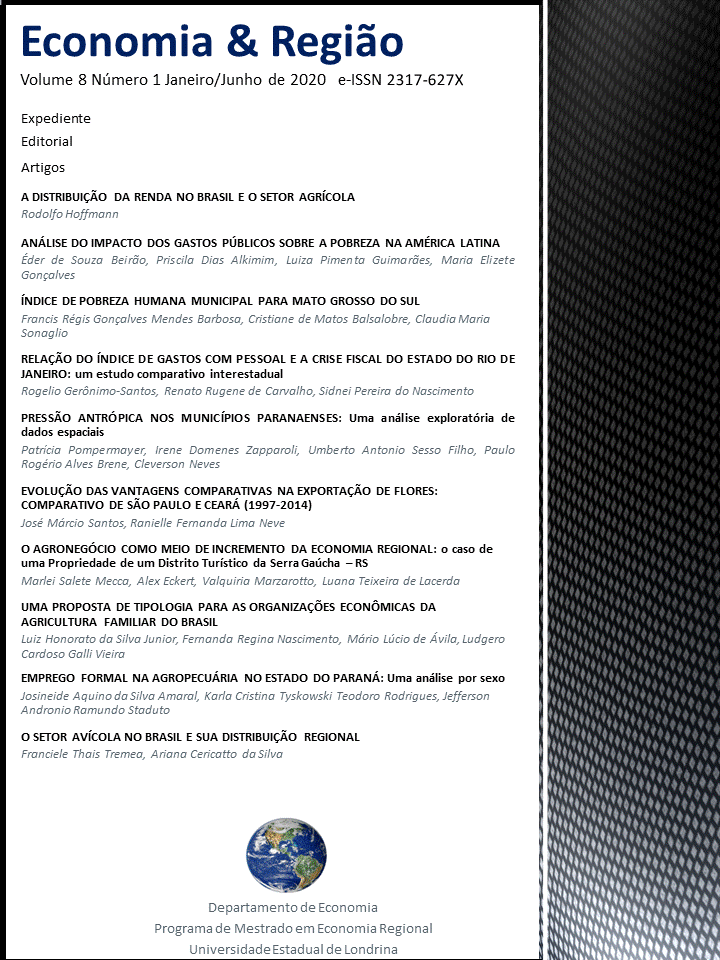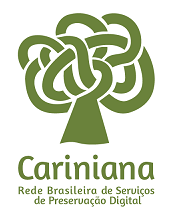Evolução das vantagens comparativas na exportação de flores: um comparativo entre os estados do Ceará e São Paulo (1997-2014)
DOI:
https://doi.org/10.5433/2317-627X.2020v8n1p109Palabras clave:
Agronegócio, Floricultura, Índice de Vantagem Comparativa Revelada de Vollrath.Resumen
O Brasil vem aumentando cada vez mais a sua participação no mercado mundial de flores. Historicamente, o Estado de São Paulo é o maior produtor e exportador nacional de flores e derivados. Entretanto, no Estado do Ceará a floricultura amplia sua participação no âmbito exportador a partir da década de 1990, apresentando maiores níveis de parcela de mercado no comércio exportador. Desta forma, surge o questionamento acerca do comportamento do segmento brasileiro de exportação de flores. Este artigo tem por objetivo geral analisar a evolução das vantagens comparativas dos estados do Ceará e de São Paulo no comércio mundial de flores entre os anos de 1997 a 2014. A metodologia consiste no cálculo do Índice de Vantagem Comparativa Revelada de Vollrath. O banco de dados foi obtido através do MDIC/SECEX com informações acerca das receitas e quantidades exportadas da floricultura dos dois estados em estudo. Os resultados mostram que o Ceará aumentou sua participação no cenário exportador a partir da década de 2000, obtendo a segunda posição em receitas totais de exportações de flores. Estes resultados, somados a uma maior presença relativa no comércio exportador, permitiram que o Ceará ampliasse sua competitividade na exportação de flores no período recente.Descargas
Citas
AGÊNCIA DE DESENVOLVIMENTO DO ESTADO DO CEARÁ – ADECE.. Exportações do Ceará no ano de 2010, como foco no agronegócio. Fortaleza, 2011. Disponível em: https://bit.ly/30k9BX4. Acesso em: 01 nov. 2016.
ARAÚJO, M. J. Fundamentos de agronegócio. 2.ed. São Paulo: Atlas, 2007. Disponível em:https://groups.google.com/forum/#!topic/adm2010uneb/uEQPOuz-PFQ. Acesso em: 09 maio 2016.
BALASSA, B. Trade liberalization and revealed comparative advantage. Manchester School, May 1965. Revealed comparative advantage revisited. Manchester School, Dec. 1977.
BALASSA, B.; NOLAND, M. “Revealed Comparative Advantage in Japan and the United States. Journal of International Economic, v. 4, n. 2, p. 8-22, 1989.
BUAINAIN, A. M.; BATALHA, M. O. Cadeias produtivas de flores e mel. In: Série Agronegócio. v.9, 2007. Disponível em: www.iica.org.br/.../cadeiasprodutivas/cadeia%20produtiva%20de%20flores%20e%20.... Acesso em: 04 maio 2016.
CARBAUGH, R. J. Economia internacional. São Paulo: Pioneira Thomson Learning, 2004.
CORRÊA, P. R.; PAIVA, P. D. O. Agronegócio da floricultura brasileira. Magistra. Cruz das Almas - BA, v. 21, n. 4, p. 253-261, out./dez. 2009.
COUTINHO, E. et al. De Smith a Porter: Um ensaio sobre as teorias de comércio exterior. 2006. Disponível em: http://www.regeusp.com.br/arquivos/362.pdf. Acesso em: 28/01/2016.
ELIAS, D. A modernização da produção agropecuária. In: ELIAS, Denise. O novo espaço da produção globalizada: o Baixo Jaguaribe - CE. Fortaleza: Edições Demócrito Rocha, 2002.
FUJIWARA, L. Floricultura se desenvolve preservando o meio ambiente gerando inclusão social: Ceará terra das flores. 2007. Disponível em: http://www.innovacionlocal.org/…ceara_terra_das_flores.pdf. Acesso em: 08 out. 2015.
GONÇALVES, R. et al. A nova economia internacional: uma perspectiva brasileira. Rio de Janeiro: Campus, 1998.
ILHA, A. S.; CORONEL, D. A. Vantagens comparativas reveladas e orientação regional da soja brasileira frente à União Europeia e ao foro de cooperação econômica na Ásia e no Pacífico (1992/2004). In: Revista de Economia e Agronegócio, Viçosa, v.4, n. 1, p. 43-62, 2006.
INSTITUTO AGROPOLOS DO CEARÁ. Panorama da floricultura no estado do Ceará 2013. Governo do estado do Ceará. 2013. Disponível em: http://faec.org.br/novo/wp-content/uploads/2014/06/Apresenta%C3%A7%C3%A3o-Panorama-2013.pdf. Acesso em: 04 jun. 2016.
INSTITUTO BRASILEIRO DE FLORICULTURA – IBRAFLOR. Dados gerais do setor. 2013. Disponível em: http://www.ibraflor.com/publicacoes/vw.php?cod=213. Acesso em: 17 maio 2016.
JUNQUEIRA, A. H.; PEETZ, M. S. 2012: balanço do comércio exterior da floricultura brasileira. In: Contexto & Perspectiva. Boletim de análise conjuntural do mercado de flores e plantas ornamentais no Brasil. Hórtica Consultoria e Treinamento, 2013.
LIMA JÚNIOR, J. C. et al. In: NEVES, M. F.; PINTO, M. J. A. (Orgs.). Mapeamento e Quantificação da Cadeia de Flores e Plantas Ornamentais do Brasil. São Paulo: OCESP, 2015. Disponível em: http://www.ibraflor.com/publicacoes/vw.php?cod=248. Acesso em: 02 out. 2016.
MEERHAEGHE, M. A. G. Economia internacional. São Paulo: Campus, 1976.
MOTA, C. C. P. et al. Participação da produção da soja na balança comercial: uma análise comparativa a partir da produção do estado do Mato Grosso, no período de 2002 a 2012. Revista de Estudos Sociais, v. 15, n. 29, p. 109, 2013.
NUNES FILHO, P. Vantagem competitiva: precedentes teóricos da análise do diamante nacional de Porter. 2006. Disponível em: http://www.adm.ufba.br/sites/default/files/publicacao/arquivo/paulo_de_souza_nunes_filho.pdf. Acesso em: 07 jan. 2016.
OLIVEIRA, A. A. P.; BRAINER, M. S. C. P. Floricultura: Caracterização e mercado. Fortaleza: Banco do Nordeste do Brasil, 2007a. Documentos do ETENE. Escritório Técnico de Estudos Econômicos do Nordeste, n. 16
RICARDO, D. Princípios de economia política e tributação. São Paulo: Abril Cultural, 1996.
SILVA, D. B. Sustentabilidade no agronegócio: dimensões econômica, social e ambiental. Comunicação & Mercado/UNIGRAN - Dourados - MS, vol. 1, n. 3, p. 23-34, jul./dez. 2012. Disponível em: http://www.unigran.br/mercado/paginas/arquivos/edicoes/3/3.pdf. Acesso em: 03 maio 2016.
VOLLRATH, T. L. A theoretical evaluation of alternative trade intensity measures of revealed comparative advantage. Weltwirtschaftliches Archiv, v. 127, n. 2, p. 265-280, 1991.
Descargas
Publicado
Cómo citar
Número
Sección
Licencia
Economia & Região adota a Licença Creative Commons Attribution CC-BY 4.0 International, portanto, os direitos autorais relativos aos artigos publicados são do(s) autor(es), que cedem à Revista Economia & Região o direito de exclusividade de primeira publicação.
Sob essa licença é possível: Compartilhar - copiar e redistribuir o material em qualquer suporte ou formato. Adaptar - remixar, transformar, e criar a partir do material, atribuindo o devido crédito e prover um link para a licença e indicar se mudanças foram feitas.

















